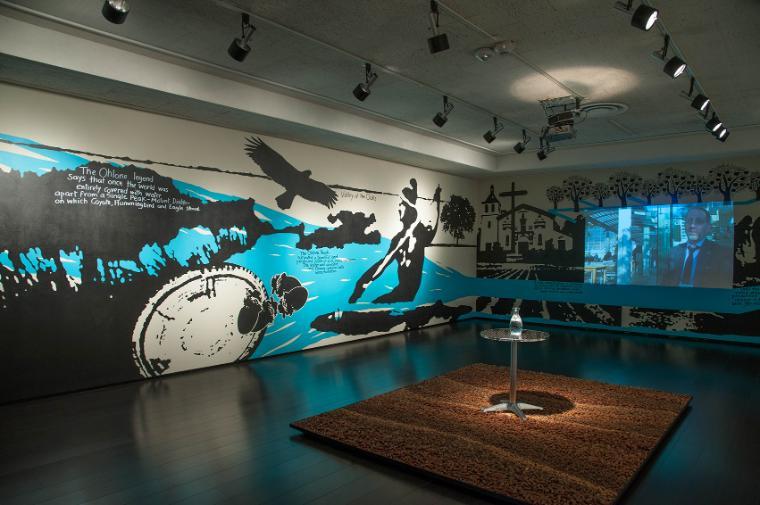
January 17 - March 16, 2014
Developed in conjunction with Around the Table, the San Jose Museum of Art's community initiative, Sip. Do Not Gulp. examines the interconnectedness of food and water throughout Santa Clara Valley's long history. Created by Bay Area artist Michele Guieu, the site-specific installation calls attention to the shifting patterns and practices of water usage in this area. Once an abundant resource, agricultural development, population increase, and urban sprawl have placed stress on fresh water availability. Comprised of a painted mural, a documentary video, and a symbolic acorn "rug," Guieu highlights the preciousness of water as a local resource and draws salient connections to food production in this region: if there is no water, there is no food.
Designed specifically for the de Saisset Museum, Guieu's painted mural extends across three walls, looking at four distinct periods in local history. As you enter the gallery, on the left wall Native California is the focus. When the Ohlone people first inhabited this region, the landscape was replete with water and other natural resources. Water is essential in the life and mythology of the Ohlone people.
The center wall of the mural addresses the Mission and Rancho periods. With the arrival of the missions came the introduction of agriculture. Irrigation systems appeared and their presence and usage only intensified during the Rancho period, where water seemed to be in unlimited supply. Also on the central wall, a documentary video made by Guieu brings together four distinct voices to address water concerns from a range of perspectives——Andrea Blum, chef and writer; James Famiglietti, Professor of Earth System Science and Civil and Environmental Engineering at the University of California, Irvine; Edward Maurer, Associate Professor, Civil Engineering at Santa Clara University; and Ann Marie Sayers, Ohlone Storyteller and Tribal Chair of Indian Canyon.
The wall on the right depicts Santa Clara Valley today, a view of San Jose sitting at the heart of Silicon Valley. No longer available in unlimited quantity, fresh water has begun to be regulated and will likely become more so as we struggle to preserve this precious resource.
In the center of the room lies a rug formed of acorns locally hand-picked from different species of oaks. Acorns were an essential food source for the Ohlone. In the middle of the rug a small table is set with a pitcher of water—a reminder that the most important thing on the menu is water. Water is a necessity for farming, cooking, and irrigating—our food supply depends on it.
From the abundant and flowing water of Native California to the present concerns and conservation efforts, water has always been at the center of our lives. It is the most precious resource we have and it needs to be a focal point for discussion. Water availability and usage will continue to become an issue across the planet—fresh water shortages due to population growth, pollution, and access. These problems already exist, even in California, but they may only grow exponentially. There is urgency to engage in this dialogue—it affects everyone.
To encourage this dialogue, Sip. Do Not Gulp. is designed to be interactive. Museum visitors are invited to share stories, commentary, and reflections on the role of water in our lives by posting comments directly onto the surface of the mural. With time, the image created by Guieu will become a forum for discussion—a place where the community can exchange ideas, express concerns, and develop solutions.
Sip. Do Not Gulp. is programmed in conjunction with Around the Table. Around the Table: Food, Creativity, Community is a community festival of activities that celebrates and explores the role food plays in our lives. 38 Bay Area organizations are presenting projects by local farmers, artists, designers, architects, performers, and activists through the spring of 2014. Highlights include exhibitions, visits to farms, performance art and theatre, lectures and panel discussion, and edible plantings downtown. For more information visit www.sjmusart.org/around-the-table.
The exhibition is supported in part by The Inouye de Saisset Museum Fund. It is made possible with the assistance of SCU's Archives and Special Collections, the Department of Art and Art History, and The Forge Garden.
Image: Installation view of Sip. Do Not Gulp. Photo courtesy of Chuck Barry.
